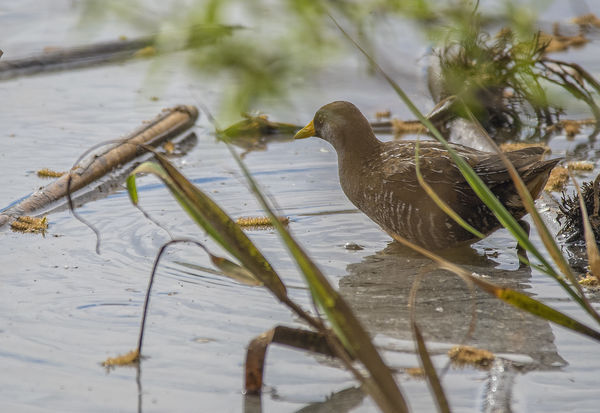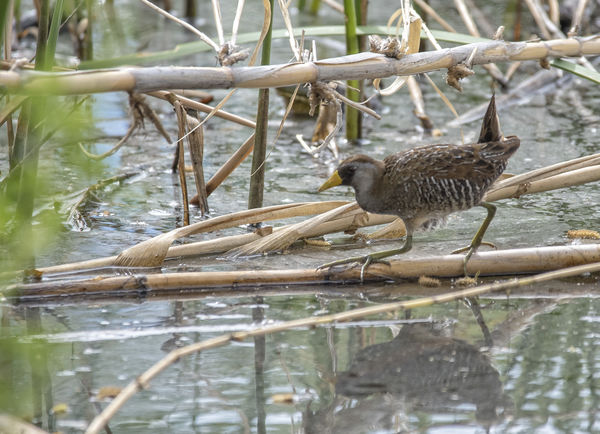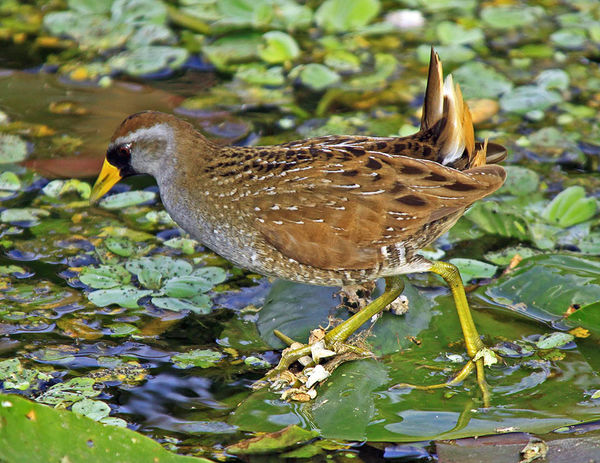ID please
Mar 25, 2018 22:35:59 #
This creature swam like a duck so I was surprised to see its feet when it got out of the water briefly. I would guess it to be part of the Heron family. I am sending 2 images but the second one is primarily so you can see the feet and face although not in good focus. Thanks.
Mar 25, 2018 22:45:29 #
Thanks anyway but it just dawned on me it might be a Rail and it looks like a Virginia or Sora Rail! Duh!
Mar 25, 2018 22:49:23 #
suntouched wrote:
This creature swam like a duck so I was surprised to see its feet when it got out of the water briefly. I would guess it to be part of the Heron family. I am sending 2 images but the second one is primarily so you can see the feet and face although not in good focus. Thanks.
It looks like a Sora to me - here is a better shot .....
They are shy and somewhat scarce ! 8-) - any shot of a Sora is a good one !
..
Mar 25, 2018 22:51:57 #
imagemeister wrote:
It looks like a Sora to me - here is a better shot .....
They are shy and somewhat scarce ! 8-)
..
They are shy and somewhat scarce ! 8-)
..
First I've seen here. It came out from under the marshy area and hid in the foliage while I pursued it :) Thanks
Mar 26, 2018 08:13:59 #
MJKilpatrick
Loc: Cape May, NJ
Hi suntouched,
As imagemeister noted it is a Sora. Maybe this info will help in the future when you run up against a rail, or go out looking for them. In the US we have several rails and they can be sorted by size, habitat and morphological features(the look, plumage, size, bill, etc). Your rail is distinctly Sora........it has a shorter bill that is yellow in color and has very distinct facial markings that separate it from the Virginia rail. The Virginia rail is a large bird and sits in the mid range of size in our rails.........the Sora is one step smaller (tough to see unless they are standing next to each other or you have seen many of both). The Virginia has a much longer bill that will look red or orange (or red-orange) where the Sora has a shot, yellow bill. Just looking at the bill of you bird points it to Sora. The Virginia does not have that distinctive black on the face so with the bill and face pattern your bird can only be a Sora. Where both bend more to the fresher water habitats, and overlap in these habitats, the Sora bends much more to the purer fresh water habitat side, the Virginia bends more to the fresh to brackish water side. The habitat and vegetation in your photos suggests you found it in a fresh, or more fresh water marsh area.
If you see more rails, these are the rails we have in the US (keep in mind any bird can show up anywhere in migration and birds stray): Clapper Rail, King Rail, Virginia Rail, Sora Rail, Yellow Rail, Black Rail. I put them in order of size (Clapper and King the largest.......Black Rail the smallest). There is a significant size difference between the largest and smallest, and when you get to the smaller rails. The Sora starts the smaller rails (Sora, Yellow and Black rail). The Black rail is a sparrow size bird and looks like a mouse in the marsh......rare to get a good, clear look at one as they stay under the grasses most of the time. The Yellow is also illusive but you probably have some out where you are, I am not sure you have Black rails there. The bigger rails have distinctly larger bills, smaller rails have shorter bills. I also arrange that list in order of habitat with the Clapper being a distinctly salt to brackish water bird then the rest are seen mostly in habitat leading from the salt marsh to the fresh water wetlands. The King is a more brackish, fresher water bird than the Clapper, usually seen just above the salinity line used by the Clapper (I should note that the Clapper and King rail look very much a like, it takes a very keen eye to distinguish between the two in the field). The Virginia is one step towards the fresh water up the salinity line......very much brackets the salinity line, the Sora is at the salinity line or above in the fresher water habitat. The Yellow rail can be found in any habitat during migration, I have seen them on the salt marsh a few times.......but they are a rarer creature....they bend more to the inland fresh water areas. The Black rail is the exception, it can be found across a number of salt marsh and fresh water habitats. Inland populations are fresh water based. East coast populations are salt and brackish water marsh based and can be found in the same regions and areas as Clappers. The big difference is the Black rail is a high marsh elevation nest bird, the Clapper a low marsh nesting bird (Elevation plays in as a factor in the different habitat bands of the rails). They use a very different vegetation as the Black rail bends to the higher marsh elevations away from the mean high tide fluctuations, the Clapper likes being in that tidal fluctuation.
The longer bills on the larger rails give away some aspect of their diet as does the smaller bills of the smaller rails. For example, Clappers have the longest bills, they are also a marsh crab specialist, they stick those bills in fiddler crab holes and pluck up fleeing crabs. The Sora, Yellow and Black rails have different diets.......lots of invertebrates and insects. The bill also gives some insight into where one might find them......find what they eat and you will likely find the bird if the habitat fits.
But, if you like rails, go back to where you saw that Sora. Sora numbers have been decreasing.......if you saw one then there is a chance there are others, or at least that bird may be in that spot for a bit. They are darters in that they do not stand still much and are usually in and out of cover. One secret to locating rails, if you know one is there, is to look for their footprints in the mud. If you see footprints continuing in spots over time then you know where that rail is coming out and in regularly. Then just sit and wait.
I hope this helps, with my best
As imagemeister noted it is a Sora. Maybe this info will help in the future when you run up against a rail, or go out looking for them. In the US we have several rails and they can be sorted by size, habitat and morphological features(the look, plumage, size, bill, etc). Your rail is distinctly Sora........it has a shorter bill that is yellow in color and has very distinct facial markings that separate it from the Virginia rail. The Virginia rail is a large bird and sits in the mid range of size in our rails.........the Sora is one step smaller (tough to see unless they are standing next to each other or you have seen many of both). The Virginia has a much longer bill that will look red or orange (or red-orange) where the Sora has a shot, yellow bill. Just looking at the bill of you bird points it to Sora. The Virginia does not have that distinctive black on the face so with the bill and face pattern your bird can only be a Sora. Where both bend more to the fresher water habitats, and overlap in these habitats, the Sora bends much more to the purer fresh water habitat side, the Virginia bends more to the fresh to brackish water side. The habitat and vegetation in your photos suggests you found it in a fresh, or more fresh water marsh area.
If you see more rails, these are the rails we have in the US (keep in mind any bird can show up anywhere in migration and birds stray): Clapper Rail, King Rail, Virginia Rail, Sora Rail, Yellow Rail, Black Rail. I put them in order of size (Clapper and King the largest.......Black Rail the smallest). There is a significant size difference between the largest and smallest, and when you get to the smaller rails. The Sora starts the smaller rails (Sora, Yellow and Black rail). The Black rail is a sparrow size bird and looks like a mouse in the marsh......rare to get a good, clear look at one as they stay under the grasses most of the time. The Yellow is also illusive but you probably have some out where you are, I am not sure you have Black rails there. The bigger rails have distinctly larger bills, smaller rails have shorter bills. I also arrange that list in order of habitat with the Clapper being a distinctly salt to brackish water bird then the rest are seen mostly in habitat leading from the salt marsh to the fresh water wetlands. The King is a more brackish, fresher water bird than the Clapper, usually seen just above the salinity line used by the Clapper (I should note that the Clapper and King rail look very much a like, it takes a very keen eye to distinguish between the two in the field). The Virginia is one step towards the fresh water up the salinity line......very much brackets the salinity line, the Sora is at the salinity line or above in the fresher water habitat. The Yellow rail can be found in any habitat during migration, I have seen them on the salt marsh a few times.......but they are a rarer creature....they bend more to the inland fresh water areas. The Black rail is the exception, it can be found across a number of salt marsh and fresh water habitats. Inland populations are fresh water based. East coast populations are salt and brackish water marsh based and can be found in the same regions and areas as Clappers. The big difference is the Black rail is a high marsh elevation nest bird, the Clapper a low marsh nesting bird (Elevation plays in as a factor in the different habitat bands of the rails). They use a very different vegetation as the Black rail bends to the higher marsh elevations away from the mean high tide fluctuations, the Clapper likes being in that tidal fluctuation.
The longer bills on the larger rails give away some aspect of their diet as does the smaller bills of the smaller rails. For example, Clappers have the longest bills, they are also a marsh crab specialist, they stick those bills in fiddler crab holes and pluck up fleeing crabs. The Sora, Yellow and Black rails have different diets.......lots of invertebrates and insects. The bill also gives some insight into where one might find them......find what they eat and you will likely find the bird if the habitat fits.
But, if you like rails, go back to where you saw that Sora. Sora numbers have been decreasing.......if you saw one then there is a chance there are others, or at least that bird may be in that spot for a bit. They are darters in that they do not stand still much and are usually in and out of cover. One secret to locating rails, if you know one is there, is to look for their footprints in the mud. If you see footprints continuing in spots over time then you know where that rail is coming out and in regularly. Then just sit and wait.
I hope this helps, with my best
Mar 26, 2018 08:18:57 #
Thanks so much for that very interesting information- appreciate it.
MJKilpatrick wrote:
Hi suntouched, br br As imagemeister noted it is ... (show quote)
If you want to reply, then register here. Registration is free and your account is created instantly, so you can post right away.




